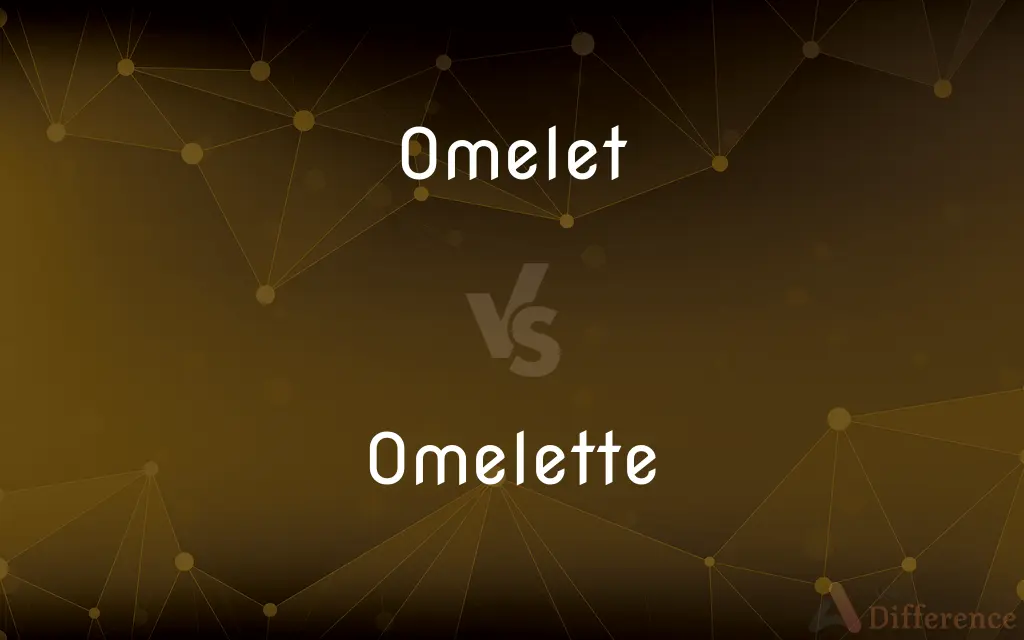Omelet vs. Omelette — What's the Difference?
By Maham Liaqat & Fiza Rafique — Updated on April 23, 2024
"Omelet" and "omelette" refer to same dish, a preparation of beaten eggs cooked until set, filled with various ingredients; the primary difference is regional spelling “omelet” is preferred in American English, while “omelette” used in British English.

Difference Between Omelet and Omelette
Table of Contents
ADVERTISEMENT
Key Differences
An omelet is a popular dish made by beating eggs and then cooking them in a frying pan until they are set. The eggs are usually folded over a filling such as cheese, vegetables, or meat. In contrast, "omelette" is simply a different spelling of the same word, used primarily in British English and other regions influenced by it, such as Australia and Canada.
The spelling "omelet" is straightforward and phonetic, which is typical of American English's tendency to simplify spellings from its British counterparts. On the other hand, "omelette" retains the French origin of the word, reflecting the typical British approach to preserving more traditional spellings.
While the ingredients and preparation method for an omelet and an omelette are the same, regional variations in terminology can also reflect slight differences in preparation styles. For example, French-style omelettes are often runnier with a smooth exterior, whereas American omelets can be cooked through more thoroughly and have a golden-brown exterior.
In culinary discussions within the U.S., you would refer to the dish as an "omelet," ensuring clarity and cultural relevance. Conversely, in a British context or in culinary schools where British English is taught, "omelette" would be the appropriate term.
Despite these differences in spelling, the global popularity of the dish means that "omelet" and "omelette" are widely understood and accepted. Both terms appear in international cookbooks and cooking websites, indicating their interchangeable use depending on the audience's preference.
ADVERTISEMENT
Comparison Chart
Spelling
Preferred in American English.
Preferred in British English.
Pronunciation
Pronounced "AHM-lit".
Pronounced "AHM-let" or "OHM-let".
Etymology
Simplified spelling from French origin.
Retains the traditional French spelling.
Common in
United States
United Kingdom, Canada, Australia
Cooking Style
Often fully cooked and firmer.
May be slightly runnier with a tender texture.
Compare with Definitions
Omelet
A dish made from beaten eggs quickly cooked with butter or oil in a frying pan.
He prefers his omelet with onions and green peppers.
Omelette
Eggs beaten and cooked until set, sometimes slightly runny in the center.
She mastered the art of making the perfect omelette.
Omelet
Represents a quick and nutritious meal option.
For a healthy option, he added spinach to his omelet.
Omelette
Can be served at any meal, reflecting its adaptability.
They served a smoked salmon omelette at the dinner party.
Omelet
Known for its simple preparation and versatility.
An omelet can be a quick meal at any time of day.
Omelette
Commonly includes fillings like mushrooms, tomatoes, and herbs.
His omelette was filled with fresh herbs from the garden.
Omelet
Often folded around a filling such as cheese, chives, or meats.
She made a cheese omelet for breakfast.
Omelette
Often cooked to be tender and creamy in texture.
Her French omelette was notably soft and creamy.
Omelet
Associated with American-style breakfasts.
An omelet with bacon and toast is his favorite breakfast combo.
Omelette
A staple in both casual and upscale British dining.
The restaurant's menu featured an herb omelette as a brunch special.
Omelet
A dish consisting of beaten eggs cooked until set and folded over, often around a filling.
Omelette
In cuisine, an omelette or omelet is a dish made from beaten eggs, fried with butter or oil in a frying pan (without stirring as in scrambled egg). It is quite common for the omelette to be folded around fillings such as chives, vegetables, mushrooms, meat (often ham or bacon), or some combination of the above.
Omelet
(US spelling) omelette
Omelette
A dish consisting of beaten eggs cooked until set and folded over, often around a filling.
Omelet
A dish consisting of eggs beaten up with a little flour, etc., and cooked in a frying pan until just set into a semisolid consistency; it may be folded around e.g. ham or cheese or jelly; as, a plain omelet. When additional ingredients are mixed in, the names of the ingredients may be mentioned in the name of the omelet; as, a ham and cheese omelet; a bacon and cheese omelet
Omelette
A dish made with beaten eggs cooked in a frying pan without stirring, flipped over to cook on both sides, and sometimes filled or topped with cheese, chives or other foodstuffs.
Omelet
Beaten eggs or an egg mixture cooked until just set; may be folded around e.g. ham or cheese or jelly
Omelette
(computing) A form of shellcode that searches the address space for multiple small blocks of data ("eggs") and recombines them into a larger block to be executed.
Omelette
Beaten eggs or an egg mixture cooked until just set; may be folded around e.g. ham or cheese or jelly
Common Curiosities
How do you make an omelet?
Beat eggs with a pinch of salt, pour into a hot, buttered pan, and cook until set. Add fillings, fold in half, and serve.
What is an omelet?
An omelet is a dish made from beaten eggs cooked in a frying pan and usually folded around fillings like cheese or vegetables.
Is there a difference between an omelet and an omelette?
The only difference is in spelling: "omelet" is American English, while "omelette" is British English. The dish itself is the same.
What are some common omelet fillings?
Common fillings include cheese, ham, vegetables, and herbs, but almost any savory ingredient can be used.
What's the secret to a perfect omelet?
Cook on medium heat until just set, add fillings, and ensure it is not overcooked to maintain tenderness.
Can you use milk in an omelet?
Yes, milk can be added to the eggs before cooking to make the omelet fluffier and creamier.
How do cultural variations affect the omelet?
Ingredients and cooking techniques can vary, reflecting local tastes and traditions, such as the use of specific cheeses or spices.
How many eggs do you need for an omelet?
Typically, 2 to 3 eggs are used per omelet, depending on the desired size.
Is an omelet considered healthy?
Omelets can be a healthy meal option when filled with vegetables and using minimal cooking fat.
How do you ensure an omelet is fluffy?
Whisk the eggs vigorously to incorporate air and consider adding a small amount of milk or cream.
Can an omelet be reheated?
Yes, though it's best when fresh, an omelet can be reheated gently in a pan or microwave.
What is the difference in texture between an omelet and an omelette?
Textural differences might vary by preparation; American omelets are often cooked through, while French omelettes may be tender and slightly runny.
What's the best pan for cooking an omelet?
A non-stick frying pan is ideal for omelets to prevent sticking and allow for easy flipping or folding.
Can you make an omelet without oil or butter?
Yes, cooking sprays or non-stick pans can reduce or eliminate the need for oil or butter.
Are omelets eaten worldwide?
Yes, variations of the omelet are popular in many different cuisines around the world.
Share Your Discovery

Previous Comparison
Cult vs. Religion
Next Comparison
Creative vs. PracticalAuthor Spotlight
Written by
Maham LiaqatCo-written by
Fiza RafiqueFiza Rafique is a skilled content writer at AskDifference.com, where she meticulously refines and enhances written pieces. Drawing from her vast editorial expertise, Fiza ensures clarity, accuracy, and precision in every article. Passionate about language, she continually seeks to elevate the quality of content for readers worldwide.














































